Tender yellow noodles in a rich savory-sweet red-orange broth served with juicy prawns, fish cakes, crunchy bean sprouts, and crispy fried shallots. {Gluten-Free adaptable}
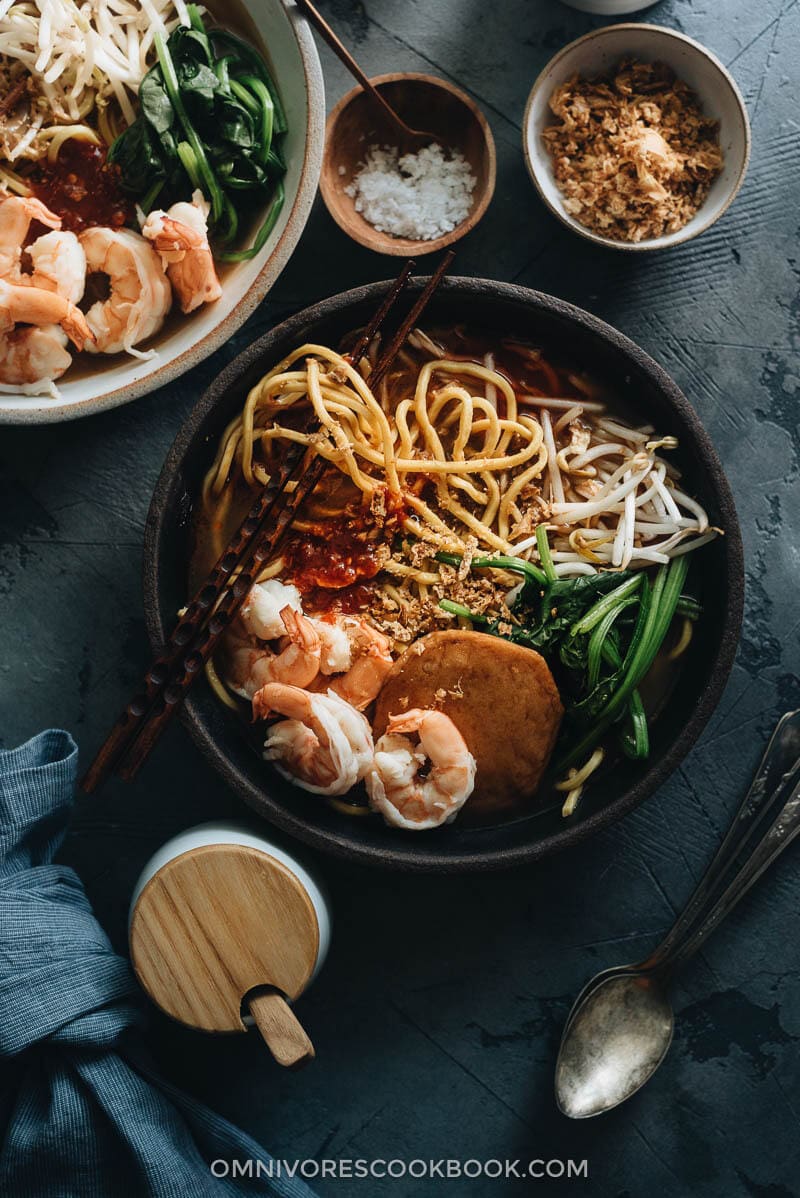
Hae Mee, or Hokkien prawn mee noodle soup, is a popular dish in Singapore and Malaysia, It is a wonderful take on the Hokkien food originating from Taiwan and the southeast of China. The cuisine has been popularized in coastal city homes all over the continent.
When I first saw this recipe in Lace Zhang’s refreshingly homey cookbook Three Dishes One Soup, it called out to me. Not only because of the exquisite images of plump prawns and sliced fish cakes sitting on a bed of thick mee noodles, in a soup whose fiery hue warns you of its spicy heat. But also because I’ve been relishing the challenge of creating southern Chinese food at home. And her book gives a great insight into upgrading this street-food staple into a labor of love for the special people in your life.
China meets southeast Asia in this sumptuous bowl, it’s a dish you can’t miss if you’re a big noodle fan like me. Making the dish does require some time and effort, but believe me, you’ll find the results worth every minute you spent.
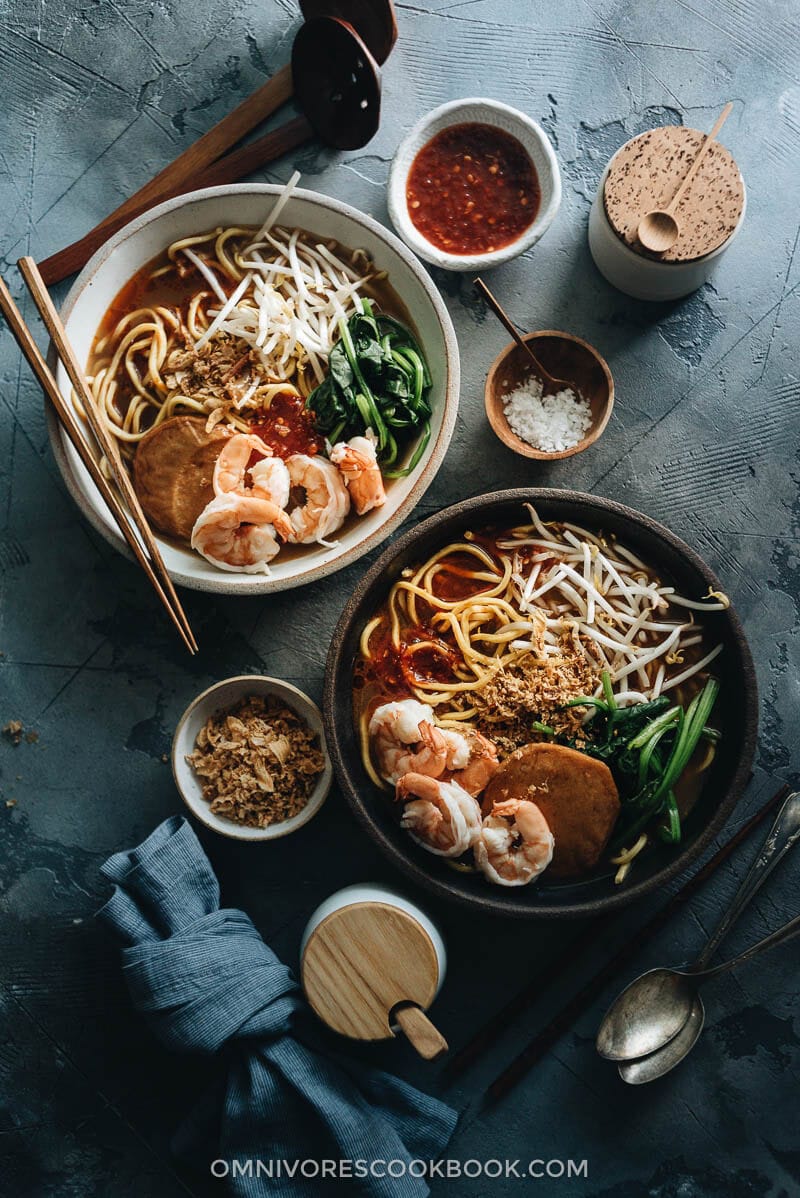
Hae Mee Cooking notes
The recipe is slightly adapted from the one in Three Dishes One Soup. I changed a couple ingredients based on what I was able to get at my local Asian market. I also reworded the instructions, so it’s easier to follow if you don’t have experience with Asian cooking. But the core spirit of the recipe remains unchanged.
1. Cooking the right cuts to make the noodle broth
Hae Mee uses a pork bone and shrimp based broth.
The best pork cuts for the noodle soup should contains bones, meat, some fat, and some skin. The fat and gelatin will melt into the soup during braising and make the soup extra rich. The original recipe calls a combination of pork ribs and a pig tail. Since pork ribs are a bit expensive and I was unable to find pigtail, I bought a pig foot with the shank attached from the Asian market. It provides a great meat-bone-skin ratio. The meat will still be juicy and flavorful after braising in the soup (See notes below on how to use the meat). And it’s very affordable. It cost me $6 to buy 3 pounds of pork that can make a big pot of soup for 4 to 6 servings.
For these bone-in cuts, you usually can find the chopped ones in an Asian market. Otherwise, ask the butcher to split the bone-in pieces using the electric saw. You can cook with a larger cut too. But smaller cuts will be so much easier to cook with and the flavor takes less time to infuse into the soup.
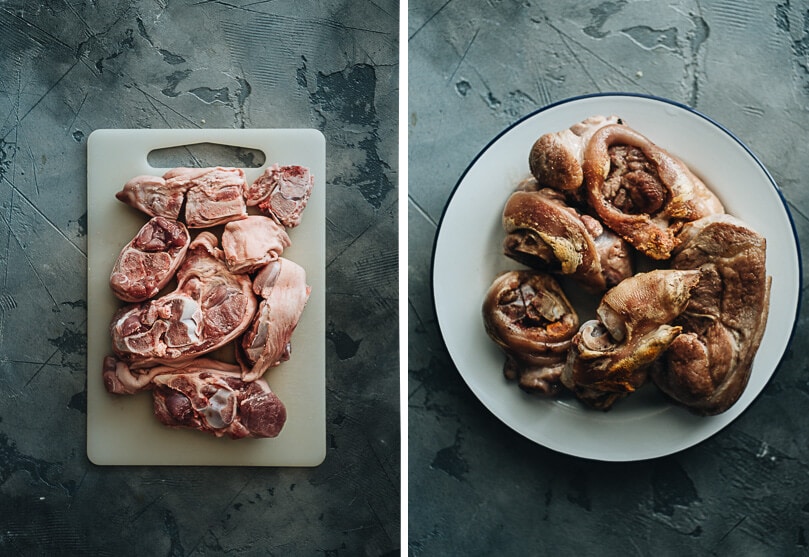
Even though traditional hae mee uses a lot of shrimp heads in the soup base, you can skip this part if you cannot find head-on shrimp. I’ve slightly adjusted the recipes with fish sauce so it will have a good taste of the sea even without the shrimp heads.
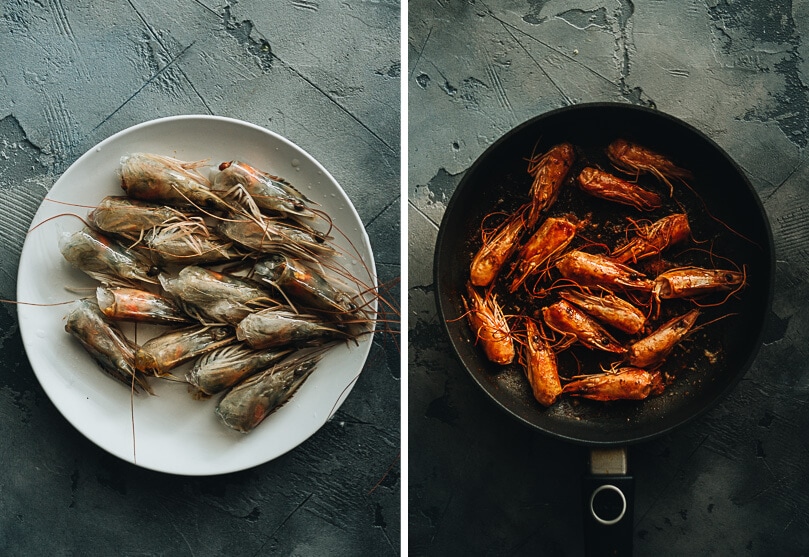
2. Simple broth, big flavor
One of the key processes to create rich hae mee broth is to brown the ingredients. In this case, browning the pork cuts, shrimp heads, onion, and rehydrated dry shrimp in a separate pan until they are well caramelized. Like other Hokkien dishes, Hae Mee uses quality ingredients to create pure broth, without adding tons of aromatics (which we use more in northern Chinese dishes). So it’s important to brown the ingredients to add another rich layer to the soup.
A side note, do use a nonstick pan or a cast iron pan for the browning process. The first time I made the dish, I mistakenly used my dutch oven to brown the pork. I thought it’d be easier to clean up if I just used one pot. Big mistake! The gelatin from the pork skin stuck to the bottom of the pan so easily, even with added oil. At the end of cooking, my white Le Creuset had turned brown and I couldn’t get the brown bits off the pan, no matter how long I soaked it…
When you brown the pork, it will cause a lot of spatter no matter how well you dry the cuts. You can use a cover to loosely cover the pan, with a small gap to let out the steam. It helps.
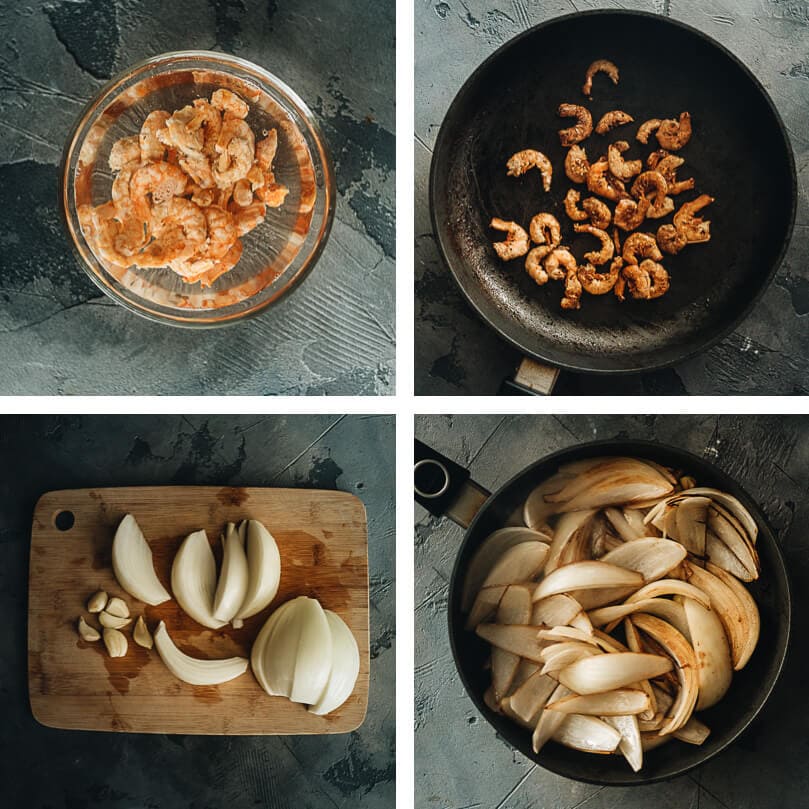
3. Type of noodles for Hae Mee
The fat, round, yellow noodles are the type you should use in Hae Mee. You can usually find them in an Asian market. Some of the Hae Mee recipes call for a mixture of rice vermicelli and the yellow noodles. However I prefer my soup with the yellow noodles only. On the other hand, you can use rice stick noodles or rice vermicelli to make the dish gluten-free. They have a different texture but work well in the recipe.
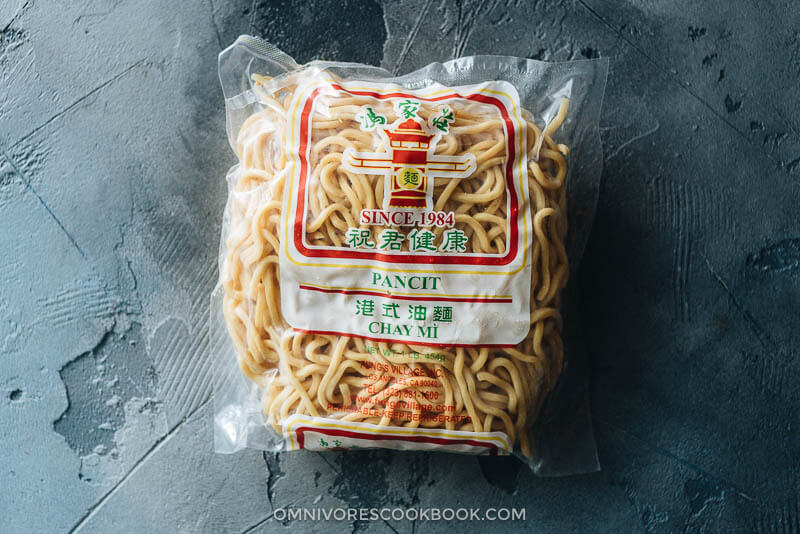
4. Topping options
Water spinach, bean sprouts, fish cakes, and boiled shrimp are highly recommended. If you cannot find water spinach, regular spinach, baby bok choy, and mustard greens work as well.
Some other great topping options include fried shallots, and sambal oelek sauce, and Sriracha sauce. The fried shallot adds a crispy texture. The sambal or Sriracha sauce can add spiciness and a hint of citrus.
And of course, you can use some of the braised meat from the soup broth as a topping. Although I did include another method below to make the meat taste more interesting.
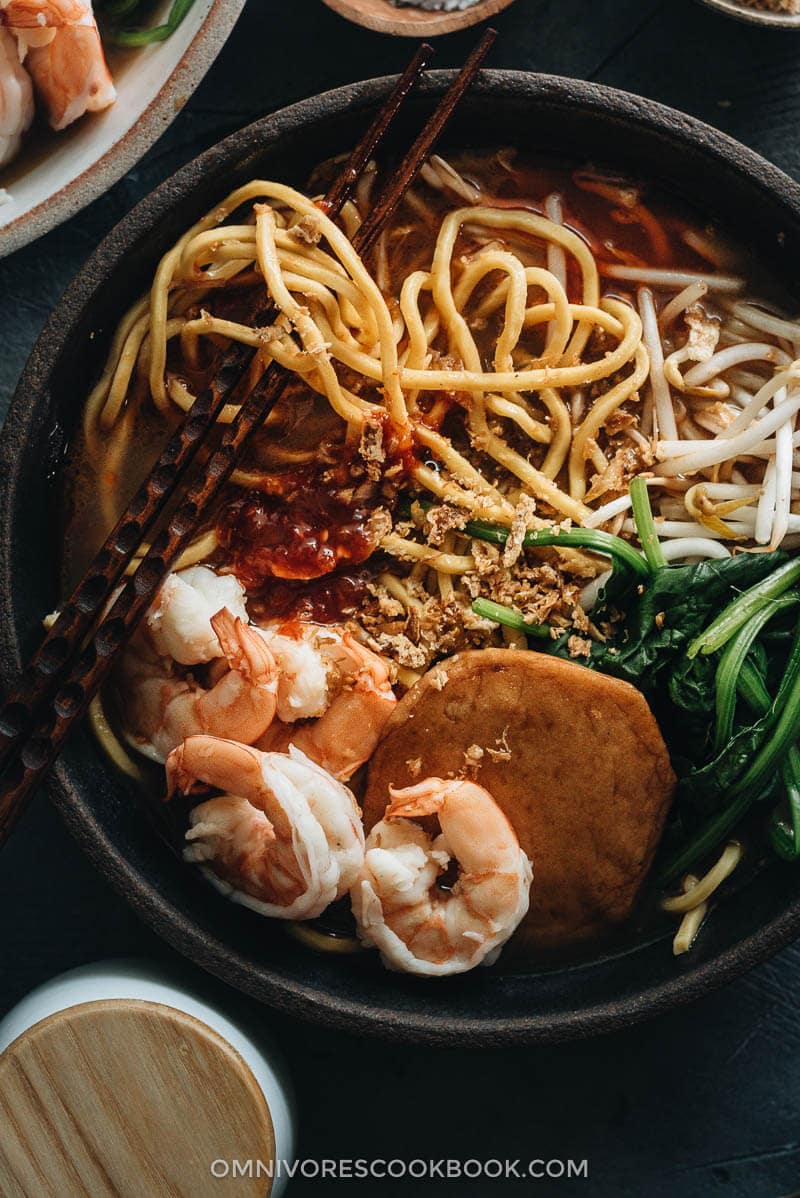
5. How to use the meat used in making the noodle broth
Traditionally, the meat from the bone soup will be discarded. Because the braising process usually overcooks the meat, so it becomes dry and tasteless. Not in this case. I found the meat from the pork shank still very juicy and tender. It’s such a waste to throw it away!
Here are two ways to use the meat.
- Serve it directly with dipping sauce. I know it’s a dumpling sauce post, but any of the sauces from this post will work well with braised meat.
- Further braise the meat with seasonings to make a stew. I used the family Pork Feet Recipe to braise the leftover cuts. I transferred the pork to a small pot big enough to hold everything in one layer. I added the braising ingredients and just enough water to barely cover the pork. Simmered for 30 minutes uncovered and I got falling-off-the-bone tender meat that was rich tasting and enough for four meals. I opted to store the meat with the sauce in the fridge overnight, and the leftover meat tasted even richer the next day!
Afterthoughts
Making Hokkien prawn mee noodle soup at home is truly a labor of love. But the result is so rewarding, plus it yields four big servings of noodle soup, plus some meat for a couple more meals. It’s also a great dish to make ahead and serve later, so it’s perfect for a dinner party if you want to impress your guests with authentic Asian noodle soup.
Happy cooking and I hope you enjoy the dish as much as I do!
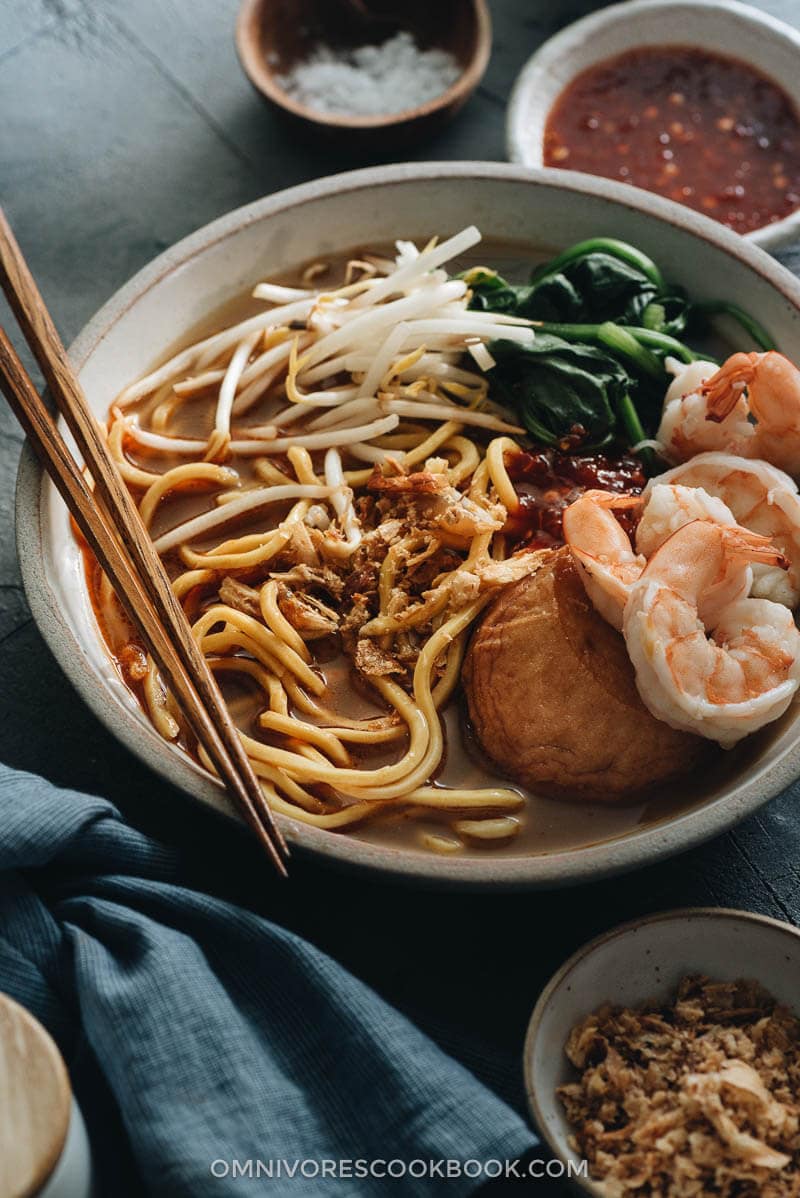
More Asian noodle recipes
- Beef Chow Fun
- Easy Singapore Noodles
- Dan Dan Noodles
- Traditional Sesame Noodles
- Cantonese Wonton Noodle Soup
- Lanzhou Beef Noodle Soup
If you give this recipe a try, let us know! Leave a comment, rate it (once you’ve tried it), and take a picture and tag it @omnivorescookbook on Instagram! I’d love to see what you come up with.
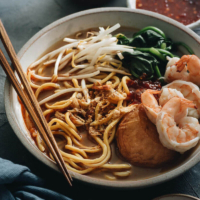
Hokkien Prawn Mee Noodle Soup (Hae Mee)
Ingredients
Stock
- 4 tablespoons peanut oil (or vegetable oil)
- 3 lbs (1.4 kg) pork meat and bone for braising (I used feet and shank), coarsely chopped (*Footnote 1)
- 1 lb (450 g) head-on shrimp (* Footnote 2)
- 1/2 cup (40 g) dried shrimp
- 4 cloves garlic , peeled
- 1 onion , coarsely sliced
- 2 tablespoons fish sauce
- 1 star anise pod
- 1 cinnamon stick
- 3 dried chili peppers
- 1 teaspoon white peppercorns
- 2 tablespoons sugar
Noodle and toppings
- 1 lb yellow noodles (or rice noodle sticks, or rice vermicelli)
- 4 cups (4 oz) water spinach (or spinach)
- 2 cups (4 oz) bean sprouts
- 4 fishcakes
- 1 tablespoon soy sauce, or to taste (Optional)
- Fried shallots, for garnish (Optional)
- Sambal oelek sauce (Optional)
Instructions
Prepare the stock
- Add 2 tablespoons oil to a large nonstick pan (or cast iron pan) and heat over medium heat until hot. Add the pork parts. Let cook for 4 to 5 minutes without touching, until the bottom is browned. Flip to brown the other side. It will take 10 to 15 minutes for the whole browning process.
- Transfer the browned pork to a 6-quart (5.5-liter) dutch oven (or a heavy-duty pot). Add 10 cups cold tap water to the pot. Cook covered until boiling. Use a fine sieve to skim the brown bits from the top of the soup and discard them.
- While boiling the broth, prepare the rest of the ingredients. Combine the dried shrimp with 1 cup warm water. Let rehydrate for 15 minutes or until soft.
- Separate the heads of the fresh shrimp from the bodies and peel the shrimp. Reserve the brown bits coming from the heads when you seperate them. This is the best part and adds tons of flavor to the soup. Transfer the shrimp heads to a small bowl, and the rest of the shrimp meat to a container. Store the shrimp meat in the fridge until ready to use (or in the freezer if you plan to serve the noodle soup more than a day from now).
- Add 1 tablespoon oil to the same nonstick pan you used to brown the pork. Heat over medium heat until hot. Add the shrimp heads. Cook until both sides turn a deep red color. Transfer heads to the stock pot. Add a ladle of water to the pan you cooked the shrimp in. Scrape off any brown bits stuck on the bottom and pour that water into the stock pot.
- Add the remaining 1 tablespoon oil, onion, and garlic to the same nonstick pan. Stir and cook until the edges turns golden brown. Transfer the onion and garlic to the stock pot.
- Add the rehydrated shrimp to the nonstick pan. Add a bit more oil if the pan looks too dry. Stir and cook until slightly browned. Transfer the shrimp to the stock pot.
- Add the fish sauce, star anise, cinnamon stick, dried chili peppers, white peppercorns, and sugar to the pot. Turn to low heat, cover, and simmer for 2 hours.
- Once done, strain the soup by setting up a big bowl (or container) with a fine sieve on the top. Ladle the soup into the bowl through the sieve, a few cups at a time. Use the back of your ladle or a pair of tongs to press the solid ingredients in the sieve, to extract any residual liquid trapped in the veggies and shrimp heads. Discard the all the solid ingredients once done straining.
- Taste the soup and adjust the flavor by adding soy sauce or salt. The soup should taste a bit salty by itself, because most of the ingredients in the noodle bowl will be boiled and not seasoned.
- Now you can use the soup base to make noodle soup, or store it in the fridge or freezer until read to use. Set the stove on lowest heat to keep the soup hot if you’re going to assemble and serve the bowls immediately.
To prepare the noodle bowls
- Bring a big pot of water to a boil. Blanch spinach for just 20 to 30 seconds, until tender. Transfer the spinach to a plate using a slotted ladle. Set aside.
- Blanch the bean sprouts the same way, until slightly tender and still crunchly. Drain and set aside with the spinach.
- Add the noodles into the same pot of water. Cook according to the instructions. Transfer to a colander, rinse with tap water and drain. Set aside.
- Add the peeled shrimp to the boiling water. Cook until the shrimp begin to curl and are just cooked through, 1 to 2 minutes, depending on the size. Drain and set aside.
- If you stored the soup base in the fridge, heat it until hot in the microwave or a pot on the stovetop.
Assemble the bowls
- Divide noodles into 4 big bowls. Ladle the soup to cover the noodles. Add the boiled shrimp, fish cakes, bean sprouts, and spinach on top. Garnish with fried shallots, if using.
- Serve the noodles hot with sambal sauce (or any other hot sauce you prefer), more fried shallots, soy sauce, and salt all on the side. This way your guests can season their noodle bowls according to their individual preferences. Enjoy!
Notes
- The best cuts of pork for the noodle soup should contain bones, meat, and skin (the gelatin will melt into the soup and make it extra rich). The original recipe calls for 1 lb (450 g) pork ribs and 1 pigtail. I found pork ribs a bit more expensive and the pigtail difficult to find. So I used 1 pig foot with the shank attached. It provides a great meat-bone-skin ratio and is very affordable. For these bone-in cuts, you can usually find them chopped in an Asian market. Otherwise, ask the butcher to split the bone-in pieces using the electric saw. You can cook with larger cuts too. But smaller cuts are so much easier to cook with.
- Shrimp heads are used in the broth to create another layer of flavor. But you can use headless shrimp, too, if head-on shrimp are not available.
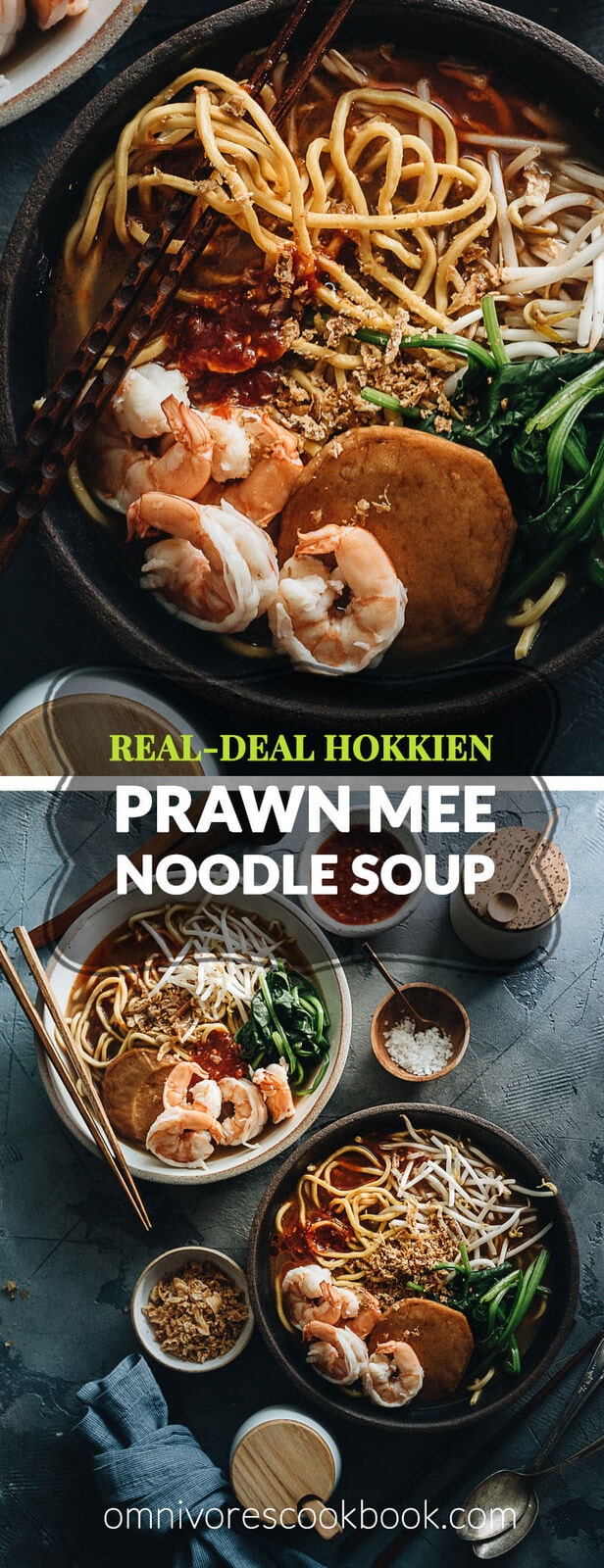













I am literally drooling on my keyboard reading this recipe. I pinned it and will totally be trying this later. The ingredients and flavors sound just incredible. I had this dish while I was in Singapore and fell in love there! Can’t wait to make this!
Perfect recipe for all season. What other side dish I can add except pork and shrimp? Prep time is short and very easy to follow the methods of cooking. I will surely cook this.
Hi Jan, I would use any sort of chicken, such as stir-fried ground chicken (or turkey), blanched and shredded chicken, or leftover rotisserie chicken etc. The broth is quite seafoody so some grilled fish can be a great side too. Some pan fried or deep fried tofu will be a great side too.
hello, thanks for sharing your recipe. do we need to first Blanche the pork ribs to get rid of the meaty smell before browning them? or just put them in the pan of oil right away without blanching?
Hi Claire, I usually directly brown the pork without blanching them first.
I used to blanch pork meat before browning when I lived in China, where the pork can have an unpleasant smell due to the type of meat and how meat is preserved. I found the pork in the US doesn’t have such issue so I’ve eliminated the process. I think it’s safe to say that as long as you use very fresh pork, you shouldn’t need to blanch it.
This was great! My family preferred stronger flavours and we adjusted the portion accordingly.
Maggie-
Are the fishcakes something I can get at the Asian market?
-Mare
Easy to prepare, tasted great! I didnt have star anise.. I substituted dried chilli peppers with dried chilli – worked well. I also used dried vermicelli instead of the yellow noodles – worked fine too. Will put this in the repertoire of recipes for meals at home. Thanks!
Hello
what type of prawns are used in this recipe?
Thanks
Bianca
I didn’t call for a specific one because I usually use whatever head-on shrimps I can find at the grocery store.